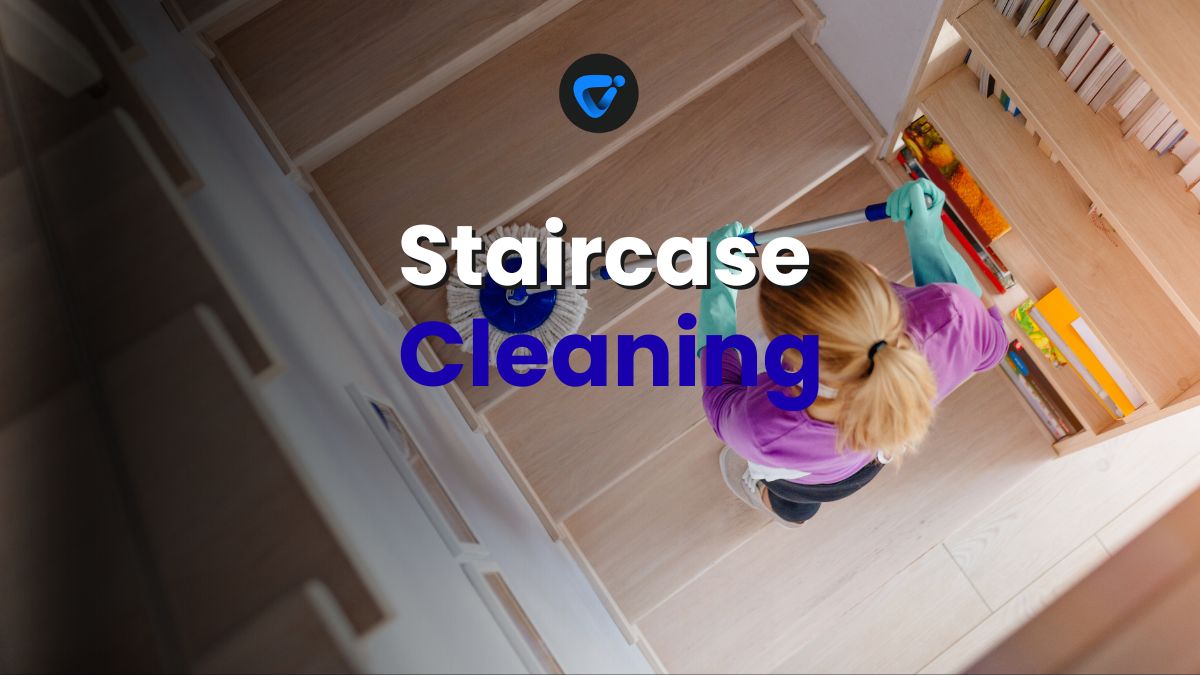
If your balcony surfaces haven’t seen a mop lately, they’re likely gathering just as much urban dust as your tabletops. Including regular balcony cleaning in your routine creates an outdoor haven you’ll actually want to enjoy.

Staircase Cleaning Safety and Effective Techniques
Clean stairs safely and efficiently! Follow our easy techniques to keep every step spotless and slip-free.
Urban apartment life offers many perks, but outdoor areas can quickly become neglected. Discolored tiles, bird droppings, and buildup turn once-charming patios into spaces you avoid. An inviting, clean balcony can transform your daily living experience.
This guide walks you through every step of effective balcony cleaning and patio tidying, complete with practical approaches, actionable checklists, and handy maintenance tactics tailored for urban apartment dwellers. Let’s roll up our sleeves and reclaim your outdoor retreat.
Reset Your Space with a Balcony Cleaning Game Plan
A smart game plan means balcony cleaning won’t feel overwhelming—you tackle it in sections and routines. Deciding what to start with helps you see fast progress and builds momentum for thoroughness.
First, scan your space for the most visible issues. Urban balconies collect grime and clutter—plan to sort items, sweep, and clear debris before fine-tuning any detail work.
Start with Removal: The Quick Sweep and Sort Script
Step outside with a trash bag and laundry basket. Say aloud, “Let’s collect anything broken, dirty, or expired.” Remove plant debris, forgotten decor, and litter in one sweep. Place loose items and cushions in your laundry basket for indoor cleaning later.
With surfaces cleared, grab a stiff broom. Sweep from one end to the other—even stubborn corners. Watch for bottle caps, bird droppings, and cobwebs. This sweep exposes the true amount of dust and where balcony cleaning is most needed.
Sift through sorted items: broken pots, faded decorations, or trash go directly in your bag. Everything clean or still useful waits near the door while you handle the floors and railings next.
Zone Your Cleaning: Corners, Edges, and High-Touch Railings
Focus on corners and balcony railings—they reveal gunk others miss. Take a damp cloth, then wipe from the top down, squeezing out grime with each pass. Notice sticky spots, mold, or mildew and flag them for targeted treatment.
Edges trap debris and dust. Use a small whisk broom or brush to pull particles away from wall seams. When hands brush against sticky panels or overlooked ledges, tackle them with a gentle cleaner and non-scratch sponge.
Scan high-touch spots like door handles and light switches before moving on. Wiping these areas at the start ensures hands stay clean as you water plants or tidy furniture during the rest of your balcony cleaning process.
| Balcony Cleaning Task | Suggested Frequency | Tool Needed | Key Takeaway |
|---|---|---|---|
| Sweeping debris | Weekly | Stiff outdoor broom | Prevents buildup and pest attraction |
| Surface wiping | Every 2 weeks | Microfiber cloth + gentle cleaner | Removes grime, makes railings safe |
| Floor washing | Monthly | Mop + bucket | Lifts stains and restores color |
| Window & glass washing | Monthly | Glass cleaner, squeegee | Keeps light bright and view clear |
| Furniture refreshing | Seasonally | Soft brush, multipurpose cleaner | Boosts comfort and outdoor enjoyment |
Choose Smart Tools and Supplies for Every Balcony Cleaning Task
Equipping yourself with the right cleaning supplies eliminates frustration and saves precious apartment storage space. Choose multifunctional tools that handle urban patio demands—dirty tiles, breezy railings, and sticky floors.
Keep balcony cleaning supplies in a labeled bin by the door so you can do quick resets as needed. This approach means less last-minute scavenging and more routine consistency.
Optimize with Space-Saving Essentials
Try collapsible buckets for floor washing—they’re easy to stash on a shelf. Microfiber cloths offer streak-free results and take up less space than stacks of paper towels or heavy sponges.
- Invest in a compact, stiff outdoor broom: gets into tile grooves, doesn’t wear down quickly, and fits behind a plant stand for easy access.
- Pick a multipurpose spray bottle: fill with gentle soap and water for both floors and furniture, saving money versus buying specialty products for each chore.
- Keep a handheld scrub brush: its bristles remove stuck grime from grout and concrete, important for preventing long-term staining on city balconies.
- Stock up on all-weather gloves: protect hands from chemicals and rough surfaces, plus stay comfortable while cleaning railings or scraping bird messes.
- Have an absorbent mop or large sponge: sops up water or spills and lets you tackle balcony cleaning even after rain or before guests arrive.
Consolidating these core tools into a single carrier keeps supplies nearby and makes cleaning less of a hassle each time dirt appears.
Eco-Friendly Cleaning Swaps
Bakers use vinegar as a leavening hack—balcony cleaning lovers use it for streak-free shine on glass. Combine white vinegar and water for plant-safe cleansing on most surfaces.
- Choose reusable microfiber pads instead of disposable cleaning wipes for floors and railings: saves waste and cleans more thoroughly with each swipe.
- Opt for biodegradable, plant-based soap in your spray bottle: gentle for pets and plants, avoids runoff that causes concrete or tile discoloration.
- Switch to pumice stone for staining: works on tough tile spots without scratching, lasts through multiple cleaning sessions so you buy less.
- Skip chemical deodorizers: sprinkle baking soda, let it sit, then sweep for natural odor control in tight balconies or next to compost bins.
- Store tools in a weatherproof tote: keeps everything dust-free and ready so you don’t waste time tracking indoor cleaning supplies outside.
Eco-friendly products not only protect your outdoor space—they also limit waste for long-term patio comfort and safety.
Deep Dive: Tackling Balcony Grime, Smudges, and Outdoor Mess
Stubborn messes on balconies deserve focused cleaning strategies. Urban grime, sticky stains, and bird droppings can all be removed with targeted effort. Prioritize safety and a step-by-step process for best results every time.
Find neglected spots by putting on gloves, getting eye level with floors and railings, and using your sense of touch for stickiness. Address what you discover immediately—delays only make stains tougher.
Scrubbing Down Urban Dust and Stains
Start balcony cleaning by moistening dried spills and letting them soak for a minute. Wipe with a microfiber cloth using circular strokes. For sticky messes, combine soap and hot water before scrubbing again—a script as simple as “Circle, pause, rinse.”
For oil stains or heavy grime, apply baking soda directly. Let sit ten minutes, then scrub with a stiff brush, reapplying water as needed. This method pulls out dirt without harming tile or concrete.
Recognize hidden patches by standing at different angles in daylight. It’s easier to spot oily smears or bootmarks and clean them before they become ingrained. Finish with a clean water rinse for all surfaces.
Removing Mold, Mildew, and Bird Droppings
Mix one part white vinegar with one part water for mildew. Spray and blot with a towel. For visible mold, wear a mask and scrub until dark spots fade—balcony cleaning here requires persistence but yields long-term results.
Bird droppings demand gloves—never scrape when dry. Wet the affected area, let it soften, then wipe with a heavy-duty cloth. If needed, repeat until the surface color returns.
After treating both issues, step back and enjoy the clearer view—a clean, healthy space reduces allergens, smells better, and invites more time outdoors. Write a reminder: check corners monthly.
Keep Outdoor Spaces Fresh with a Consistent Cleaning Routine
Maintaining balconies and patios is easier when routine meets reality. Short, regular sessions are more effective than waiting for a deep-clean marathon. Think of balcony cleaning as an extension of indoor chores for sustainable results.
Visibility matters: a checklist posted by the exit reminds you when the last sweep or washing happened. Attach cleaning cues to existing habits—like taking out trash or watering plants.
Sample Micro-Cleaning Checklists for Busy Schedules
Keep a dry-erase board with deadlines: “Monday: Sweep. Friday: Wipe railings. Last Sunday: Mop.” Visual reminders reduce decision fatigue and prompt balcony cleaning before dirt builds up.
Combine UV checks with chores: spot clean railings when they sparkle in morning light—quickly swipe away dust with a handy cloth while waiting for coffee to brew.
Enlist a partner or roommate for speed: one person collects clutter while the other sweeps. Trade tasks or chat as you work—balcony cleaning pairs well with a short catch-up talk or podcast episode.
Weather-Adaptive Maintenance
Check the weather before cleaning—rains wash away dust but may leave mud behind. Schedule deep cleans just after storms, when debris is soft, for less scrubbing effort.
During dry spells, balcony cleaning should include damp mopping for fresher air. Adjust routines by season: more sweeping in polleny spring, more washing in sticky summer, and extra checks for ice during winter.
Use a timer for quick resets: 10 minutes of focused sweeping or wiping fits into most daily routines and keeps patios looking inviting with minimal sweat.
Frequently Asked Questions
Skip harsh chemicals, abrasive scrubbers, and high-pressure hoses. These methods can damage surfaces, increase slip risk, and disturb neighbors with runoff or noise.
Create a barrier by placing an outdoor rug or runner. Wipe surfaces weekly with a damp cloth and close balcony doors during peak construction for less new dust inside.
Regular balcony cleaning removes food crumbs, standing water, and nesting material—all of which discourage pests. Use tight-sealing trash bins and occasionally sprinkle natural deterrents like coffee grounds in corners.
Shake cushions outside, then spot-clean with mild, plant-based soap. Rinse well and air-dry in the sun. For deep odors, sprinkle baking soda before scrubbing. Test on small hidden areas first.
Yes: always check building rules for allowed cleaning solutions and timing. Use contained water buckets (never hose down), clean up residue, and communicate cleaning times with neighbors in shared hallways.

Pantry Organization and Deep-Clean Checklist
Transform your kitchen fast! Follow our pantry organization and deep-clean checklist for a fresh, clutter-free space.


